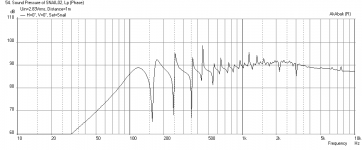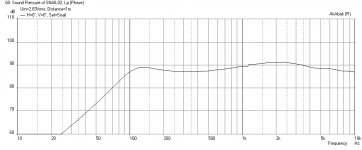I am still trying to figure out the proper way to implement damping. There is a term that allows me to simulate non-adiabatic compression - which is what I think happens in the fibers as they absorb heat of compression waves so that the energy is not released on expansion.
Here is an AkAbak sim of the 173 cm long Snail TL. I assumed a rectangular cross section starting at 6 in (H) x 6 in (W) and tapering to a 1.5 in (H) x 6 in (W). I used moderate stuffing inside the whole line and speaker is positioned 36 in from back wall, 40 in high above floor, and depth of cabinet is assumed to be 16 in deep. The Visaton FR13 is a 6.5 in class high Qts driver (Qts=1.25).
Hi X, Thank you for your time. The diameter of the opening is 6". This tapers down to 0 on the height and width. (These are the internal box measurements). The depth is 28.8".
Where my taper is slightly irregular, from the tail, the first 180degrees uses the same angle, thus, the increased increments of the diameter cross section are regular. The next 180degrees, the angles change, and are all different. This means that the taper diameter cross section changes and is not a straight line increment. The last 360degrees go back to using the same angles, so once again the increased increments of the diameter cross section are regular till it reaches the mouth at 6".
I do wonder if this changes the price of fish.
Also using a rectangular cross section would not be the some as a circle - please let me know if I'm misunderstanding this?
The depth is 28.8".
That the length? If so, your TL will be good to about 200 Hz.
Also using a rectangular cross section would not be the some as a circle - please let me know if I'm misunderstanding this?
At the frequencies of interest only the cross-section area matters.
dave
By depth, you mean physical size of cabinet all rolled up? The TL length is still 173cm right? Only the cross sectional area matters at these freq - so any shape can work - although a round cross section will have a quadratic csa as a function of distance versus a linear change in csa vs distance for a fixed width rectabgular csa that tapers. It will be a minor effect. I actually modeled it with a zero csa on the tail but saw very little difference when going to 1.5 in when sealed. This let me put a 1.5 x 6 in vent on the end.
The TL length is still 173cm right?
.
That would be good to somewhere <100 Hz.
dave
Hey guys. Being that this is a logarithmic spiral, I think that there are many ways you can interpreter the measurements. (As with government statistics.)
What I will do when I have the spare time at some point today, is post a few images with measurement, which would show a cross section rolled up. And one which is un-rolled. Thinking about it, I have noticed that I have created a throat which may not me helping, though I have no data to prove this. This throat was created due to the nature of the spiral, and had to work out how to overcome the problem with regards to starting of the tail to equal 0 diameter on the cross section. It would be interesting from my point of view what the dynamics would be if this was opened up like a chamber.
Please understand that I have been looking at this design from a logical point of view. IE, being a builder, when plumbing, what happens to the pressure of water when you change to pipe diameter. (If that makes sense.)
What I will do when I have the spare time at some point today, is post a few images with measurement, which would show a cross section rolled up. And one which is un-rolled. Thinking about it, I have noticed that I have created a throat which may not me helping, though I have no data to prove this. This throat was created due to the nature of the spiral, and had to work out how to overcome the problem with regards to starting of the tail to equal 0 diameter on the cross section. It would be interesting from my point of view what the dynamics would be if this was opened up like a chamber.
Please understand that I have been looking at this design from a logical point of view. IE, being a builder, when plumbing, what happens to the pressure of water when you change to pipe diameter. (If that makes sense.)
Last edited:
A driver and a throat are not always bad things - especially a properly designed one used on a BLH - often helps to extend the bass and smooth the response. In a sealed TL, probably not a good thing because the point was to reduce any sudden changes in CSA to prevent acoustic impedance mismatches to prevent reflections or standing waves. It may significantly impact the predicted and measured performance though.
That would be good to somewhere <100 Hz.
dave
Are you talking about the open ended tail or sealed? If open, the 100 Hz is consistent with the sim results:

Sparrowlegs,
I am tweaking the level of damping and I removed the effects of nearby walls and floor to see what the contribution from the TL alone is. The tail tapers down to essentially zero (cannot have a zero waveguide throat/mouth). If you imagine the peaks smoothed over, it looks like this TL will provide a flat response almost down to 100 Hz. So playing with the level of stuffing is critical. It doesn't work at all without any stuffing - looks very bad.
Sealed Snail:
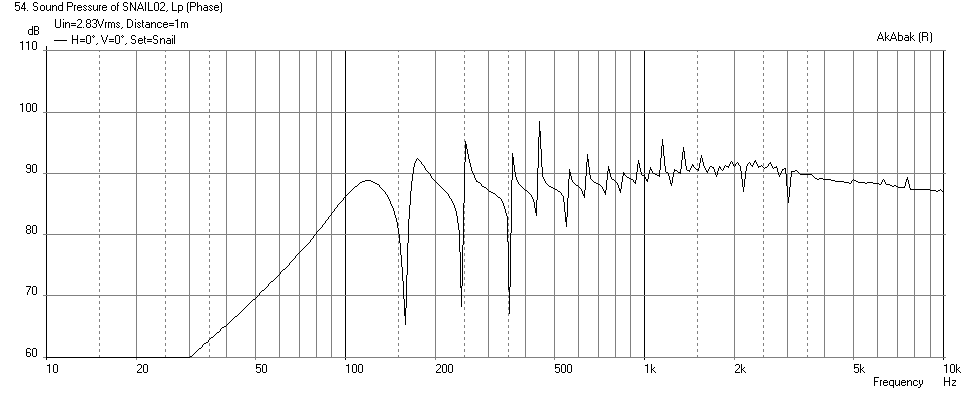
Equivalent 44 liter (volume you provided me) sealed cabinet with Qb/fo=0.1 (well damped)
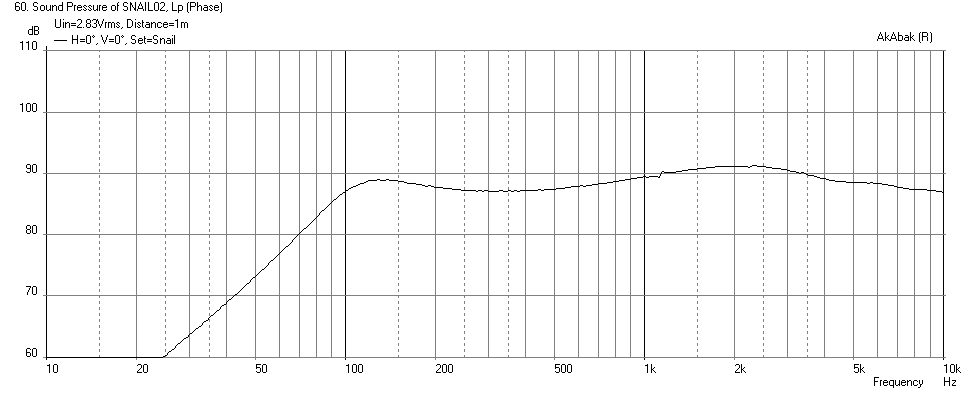
So if you will have a sub or helper woofer augment the bass, this can work out.
I am tweaking the level of damping and I removed the effects of nearby walls and floor to see what the contribution from the TL alone is. The tail tapers down to essentially zero (cannot have a zero waveguide throat/mouth). If you imagine the peaks smoothed over, it looks like this TL will provide a flat response almost down to 100 Hz. So playing with the level of stuffing is critical. It doesn't work at all without any stuffing - looks very bad.
Sealed Snail:

Equivalent 44 liter (volume you provided me) sealed cabinet with Qb/fo=0.1 (well damped)

So if you will have a sub or helper woofer augment the bass, this can work out.
Attachments
Last edited:
Are you talking about the open ended tail or sealed? If open, the 100 Hz is consistent with the sim results:
Closed. I took the length, and calced a 1/2 w/l. This is the frequency that the line will act as a half-wave, it tells nothing about actual response once a driver is added.
dave
This might be relevant to your build Sparrowlegs. My spiral sealed TL works very well - super flat freq response and the best impulse response - dynamics are very clean.
http://www.diyaudio.com/forums/full-range/223313-foam-core-board-speaker-enclosures-204.html#post3734677
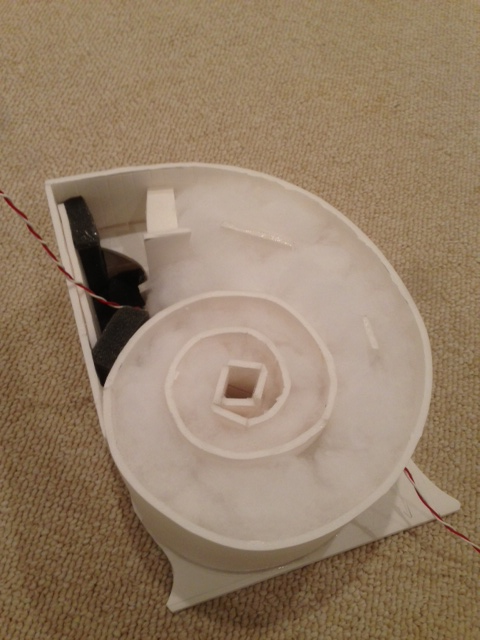
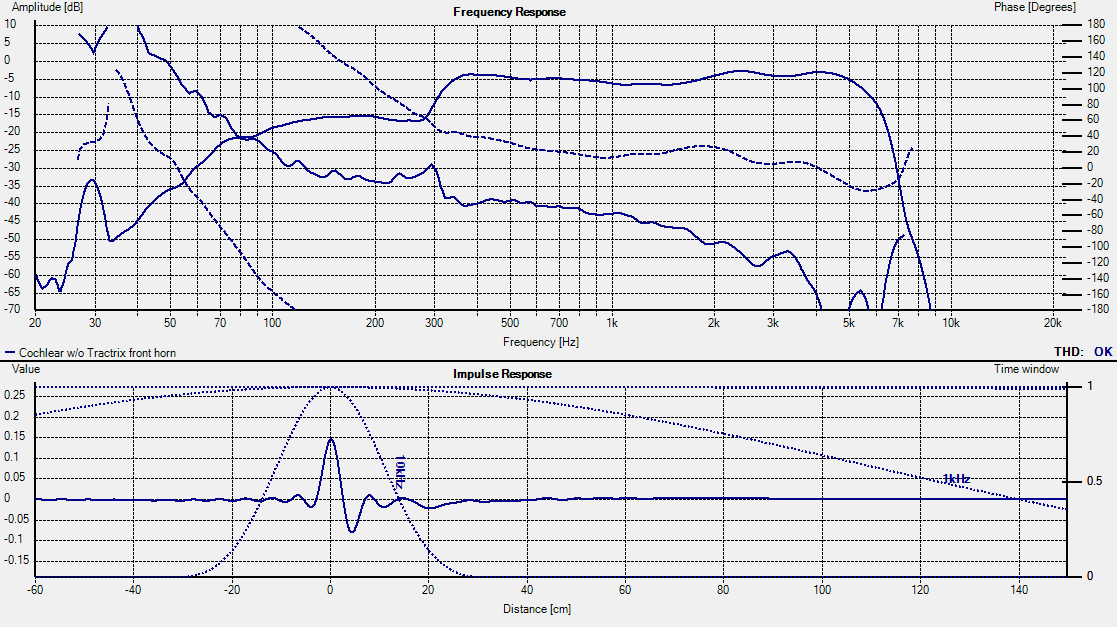
Although based on wavelength/2, the TL freq should be about 156 Hz but I see the freq measure at 330 Hz.
http://www.diyaudio.com/forums/full-range/223313-foam-core-board-speaker-enclosures-204.html#post3734677


Although based on wavelength/2, the TL freq should be about 156 Hz but I see the freq measure at 330 Hz.
Hi Guy's, it's been a while.
Not speaker related, but my project has been put on hold as I'm in the middle of moving, buying a house and re-organising my business. Oh, and battling with the little one's as they keep playing with my speaker sections...
XRK971 - Thanks for the input. In the new year I think we should be resettled and ready to start up again!
Not speaker related, but my project has been put on hold as I'm in the middle of moving, buying a house and re-organising my business. Oh, and battling with the little one's as they keep playing with my speaker sections...
XRK971 - Thanks for the input. In the new year I think we should be resettled and ready to start up again!
Good luck on the move and settling in. The above measurement had a room floor bounce that caused the dip at 300 Hz. Here a new measurement with some room treatments added. Looks much better - an excellent monitor from 150 Hz on up. I am building the stereo pair to this one today.
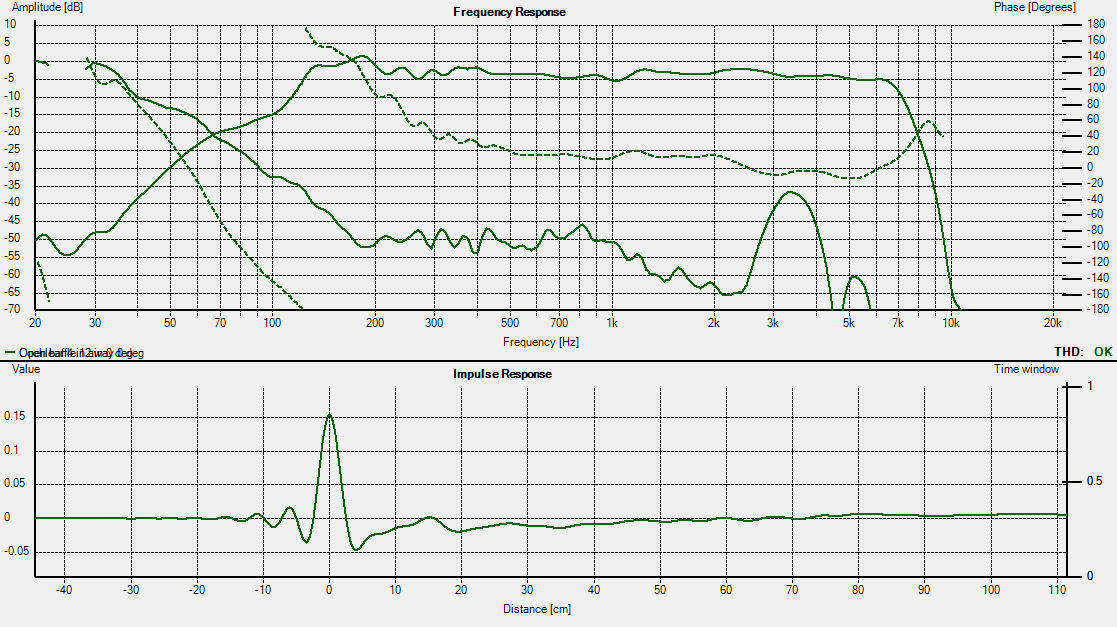

The Nautilus is back.
Hi Guys,
Its been a very long time since I've been on this forum...
The project is back on track. Still being a heretic, the nautilus shaped cabinet are being built first, with the final adjustment being made once I've chosen the driver, (though I know what I'm going to go for).
The cabinets WILL be finished before Christmas!
A few things which I need a refresher in; working out how to use the Sim Mathcad/ Win ISD etc, and how to interoperate the graphs.
Everyone will hate me, but I'm looking to use the Fostex FE208EX in a sealed tapered tube cabinet...
Thoughts and URL pointers for sims and background reading welcome.
PS come and like my FB page - https://www.facebook.com/SparrowLegsSpeakerDesign
Hi Guys,
Its been a very long time since I've been on this forum...
The project is back on track. Still being a heretic, the nautilus shaped cabinet are being built first, with the final adjustment being made once I've chosen the driver, (though I know what I'm going to go for).
The cabinets WILL be finished before Christmas!
A few things which I need a refresher in; working out how to use the Sim Mathcad/ Win ISD etc, and how to interoperate the graphs.
Everyone will hate me, but I'm looking to use the Fostex FE208EX in a sealed tapered tube cabinet...
Thoughts and URL pointers for sims and background reading welcome.
PS come and like my FB page - https://www.facebook.com/SparrowLegsSpeakerDesign
An externally hosted image should be here but it was not working when we last tested it.
Been doing some background reading as well as using some of the sim software, but may need be walked though (in my case, CARRIED!)
I'm trying to use Leonards Audio TL software, drawing my tapered tube, 78"2 opening, 2m length finishing with a 0"2 point, 85L volume. Finding this a little difficult to draw as sealed box...
I want to try different drivers so I got a list of TS Parameters from the .Db file in WinISD... why are my graphs coming out all weird?
I'm trying to use Leonards Audio TL software, drawing my tapered tube, 78"2 opening, 2m length finishing with a 0"2 point, 85L volume. Finding this a little difficult to draw as sealed box...
I want to try different drivers so I got a list of TS Parameters from the .Db file in WinISD... why are my graphs coming out all weird?
Question, where to go next?
So, out of pure determination my first speaker build was a sort of sealed IB design.
https://www.facebook.com/SparrowLegsSpeakerDesign/posts/917947391637555
Initially I miss took it to be a TL, soon realising that being sealed, this wasn't the case. (A great learning curve for a first time builder!).
However due to the way I went about building the enclosure, it isn't do difficult to change the TL length, volume, port size and CSA to turn the snail into a FL horn, QWTL, RL Horn etc.
My question is, how much does an enclosure really matter? I've noticed that a large majority of high end speakers are more reliant on active cross-overs using multiple drivers to achieve a perfect SPL across the frequency range. (Correct me if I'm wrong.)
I don't have deep pockets and my technical knowledge is still sketchy (for the moment at least), so active cross-overs and multiple drivers are out the window. Wanting to keep it simple, what enclosure type would you guys suggest to get the broadest smooth frequency range?
Also could you get a tuned enclosure to be as good (based on the pricetag) as an all singing, all dancing production speaker?
So, out of pure determination my first speaker build was a sort of sealed IB design.
An externally hosted image should be here but it was not working when we last tested it.
https://www.facebook.com/SparrowLegsSpeakerDesign/posts/917947391637555
Initially I miss took it to be a TL, soon realising that being sealed, this wasn't the case. (A great learning curve for a first time builder!).
However due to the way I went about building the enclosure, it isn't do difficult to change the TL length, volume, port size and CSA to turn the snail into a FL horn, QWTL, RL Horn etc.
My question is, how much does an enclosure really matter? I've noticed that a large majority of high end speakers are more reliant on active cross-overs using multiple drivers to achieve a perfect SPL across the frequency range. (Correct me if I'm wrong.)
I don't have deep pockets and my technical knowledge is still sketchy (for the moment at least), so active cross-overs and multiple drivers are out the window. Wanting to keep it simple, what enclosure type would you guys suggest to get the broadest smooth frequency range?
Also could you get a tuned enclosure to be as good (based on the pricetag) as an all singing, all dancing production speaker?
Initially I miss took it to be a TL
Looks like a half-wave TL to me -- they are sealed (or open at both ends)
dave
- Status
- This old topic is closed. If you want to reopen this topic, contact a moderator using the "Report Post" button.
- Home
- Loudspeakers
- Full Range
- My first build - Affordable Transmission Line spiralled Loud Speaker
